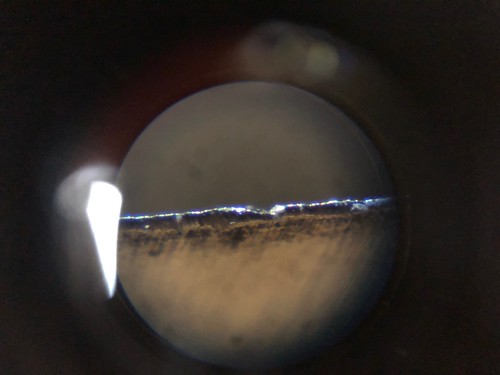I mentioned in one of the recent sharpening threads that I think most people should buy a small hand scope before they spend much money on sharpening goods. The one I ordered from china arrived yesterday, and it actually works on my PC.
It claimed a lot of resolution, but I think it's default is 640x480, which should bring folks back to the 80s or 90s in terms of looking at it.
But, I did nothing to install software or whatever else, just plugged it into a win 10 computer and turned on the "camera" default program and selected it. The system sees it just as a camera and that's it.

First picture was the black handled knife in another thread. What you're looking for is an uninterrupted line at the edge of a tool with no significant non-uniform scratches running into an edge. This hand held scope, cheapest I could find, looks like it's about 75-100x optical, and has a little stand. You can see things you'd never see under a loupe and if you have some sharpening materials you want to compare, you'll be able to see the difference in what they do. On the image above, the sharpening method is bench stone, knife ceramic (shaped like a steel), buffer. So the last black part is a combo of knife ceramic and buffer.
This is what I see with a block plane iron on one of my shelves, something I'd only use generally to test a method. that was the case here. I don't know what condition it's in, but it looks like the back was sharpened with a washita - notice how much less clear the scratches are at the back, but the washita or something like a 6-8k waterstone isn't really that fine compared to stuff that's a lot cheaper.

It's fine enough. The colorful look on the back is partially due to oil.

And the bevel side of the same iron. The cakey stuff is wood. So I was using this. But apparently not much because there is nothing other than a little bit of wear.
Just my opinion, but if the expenses go into expensive stones, expensive guides, etc, you probably owe it to yourself first to get something cheap to confirm that the fine scratches are getting to the edge. If you look at the scratches under the woody junk, those may be india stone - I'm not sure, but you can see how easily they'd be seen if they went all the way to the edge, plus you'd see a little divot where they terminate.
You'll also find that the abrasives that allow for the fastest and finest in combination are probably some of the cheapest.
It claimed a lot of resolution, but I think it's default is 640x480, which should bring folks back to the 80s or 90s in terms of looking at it.
But, I did nothing to install software or whatever else, just plugged it into a win 10 computer and turned on the "camera" default program and selected it. The system sees it just as a camera and that's it.

First picture was the black handled knife in another thread. What you're looking for is an uninterrupted line at the edge of a tool with no significant non-uniform scratches running into an edge. This hand held scope, cheapest I could find, looks like it's about 75-100x optical, and has a little stand. You can see things you'd never see under a loupe and if you have some sharpening materials you want to compare, you'll be able to see the difference in what they do. On the image above, the sharpening method is bench stone, knife ceramic (shaped like a steel), buffer. So the last black part is a combo of knife ceramic and buffer.
This is what I see with a block plane iron on one of my shelves, something I'd only use generally to test a method. that was the case here. I don't know what condition it's in, but it looks like the back was sharpened with a washita - notice how much less clear the scratches are at the back, but the washita or something like a 6-8k waterstone isn't really that fine compared to stuff that's a lot cheaper.

It's fine enough. The colorful look on the back is partially due to oil.

And the bevel side of the same iron. The cakey stuff is wood. So I was using this. But apparently not much because there is nothing other than a little bit of wear.
Just my opinion, but if the expenses go into expensive stones, expensive guides, etc, you probably owe it to yourself first to get something cheap to confirm that the fine scratches are getting to the edge. If you look at the scratches under the woody junk, those may be india stone - I'm not sure, but you can see how easily they'd be seen if they went all the way to the edge, plus you'd see a little divot where they terminate.
You'll also find that the abrasives that allow for the fastest and finest in combination are probably some of the cheapest.



































